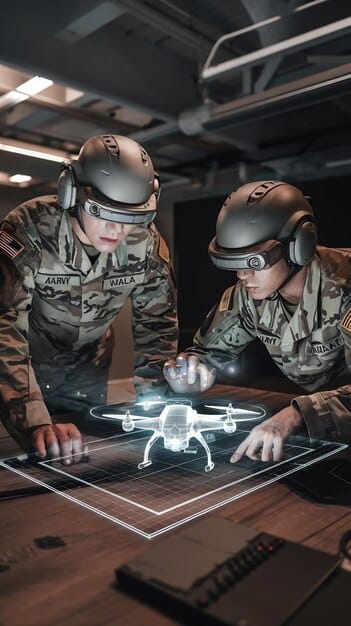Defense Industry Training: Preparing Workforce for Future Warfare

The defense industry faces a critical imperative to adapt its workforce through specialized training, ensuring preparedness for the evolving landscape of future warfare characterized by advanced technology and complex threats.
In a world where geopolitical landscapes shift with increasing velocity, the defense industry stands at a pivotal juncture. The very nature of conflict is undergoing a profound transformation, driven by technological leaps and the emergence of new adversaries. How can companies in this sector ensure their human capital is not just keeping pace, but actively shaping the future? The answer lies in targeted, forward-thinking Defense Industry Training: How Can Companies Prepare Their Workforce for the Future of Warfare? This preparation isn’t merely about honing existing skills; it’s about cultivating adaptability, embracing innovation, and fostering a deep understanding of tomorrow’s operational environments.
The Evolving Landscape of Modern Warfare
The traditional battlefields and tactics of yesteryear are rapidly being redefined by advancements in technology and shifts in global power dynamics. Modern warfare is no longer confined to physical fronts; it extends into cyberspace, outer space, and the electromagnetic spectrum. This necessitates a workforce that is not only proficient in conventional military operations but also deeply skilled in areas like cyber defense, artificial intelligence, and quantum computing.
Consider the proliferation of unmanned aerial vehicles (UAVs) and autonomous systems. These tools offer unprecedented capabilities for surveillance, intelligence gathering, and precision strikes, but they also introduce complex ethical and operational challenges. A workforce trained to understand the full lifecycle of these systems – from design and development to deployment and maintenance – becomes invaluable. Similarly, the rise of sophisticated cyberattacks, targeting critical infrastructure and military networks, demands experts capable of proactive defense and rapid response. The threats are no longer just kinetic; they are informational, economic, and psychological.
Cyber Warfare and Digital Resilience
The digital domain has become an undeniable theater of conflict, demanding a workforce with profound expertise in cybersecurity. Companies must prioritize training that encompasses:
- Threat Intelligence: Understanding emerging cyber threats, attack vectors, and adversary methodologies.
- Defensive Operations: Skills in network hardening, intrusion detection, and incident response.
- Offensive Capabilities (Ethical Hacking): Training in penetration testing and vulnerability assessment to proactively identify weaknesses.
These skills are integral for protecting sensitive data, intellectual property, and critical operational systems from state-sponsored actors and sophisticated criminal enterprises. The ability to defend against, and if necessary, counter, digital aggression is paramount for maintaining a strategic advantage.
The shift towards data-centric operations further emphasizes the need for a digitally literate workforce. From advanced analytics to machine learning, extracting actionable insights from vast datasets is crucial for intelligence, logistics, and strategic planning. Investing in human capital with these skills means investing in a more informed and agile defense posture. This holistic understanding of the digital battleground allows for more comprehensive and adaptive training programs that can truly prepare personnel for the multifaceted threats of modern conflict.
Strategic Workforce Development and Talent Acquisition
In the highly specialized and competitive defense sector, strategic workforce development goes beyond simply upskilling current employees; it involves a comprehensive approach to talent acquisition, retention, and continuous learning. Companies must proactively identify future skill gaps and implement robust pipelines to ensure a steady supply of qualified personnel. This includes fostering relationships with educational institutions, investing in apprenticeship programs, and creating clear career pathways to attract and retain top talent.
The defense industry often grapples with a unique set of challenges, including lengthy project cycles, strict security clearances, and a rapidly evolving technological landscape. These factors underscore the need for a flexible and adaptable workforce development strategy. It’s not enough to hire individuals with specific certifications; companies need to cultivate employees who possess a strong foundation in critical thinking, problem-solving, and cross-disciplinary collaboration. The ability to integrate diverse expertise—from engineering and cybersecurity to data science and geopolitics—becomes a significant competitive differentiator.
Attracting and Retaining Specialized Talent
The demand for specialized skills in areas like AI, quantum computing, and advanced materials often outstrips supply. Defense companies must develop strategies to compete effectively for these highly sought-after professionals:
- Competitive Compensation and Benefits: Offering packages that rival those in the commercial tech sector.
- Engaging Work Environments: Providing opportunities for challenging, impactful work on cutting-edge projects.
- Professional Development Opportunities: Clear pathways for continuous learning, skill enhancement, and career progression.
These elements are crucial for both attracting new talent and retaining experienced personnel who might otherwise be drawn to other industries. Moreover, creating an inclusive and diverse workplace culture can broaden the talent pool, bringing in fresh perspectives and fostering innovation.
Long-term workforce planning is essential. This involves not only forecasting future skill requirements but also understanding demographic shifts within the existing workforce. As experienced professionals retire, capturing their institutional knowledge and effectively transferring it to new generations of employees becomes a critical task. Mentorship programs, knowledge management systems, and formalized training for succession planning are vital components of this strategic approach.
Leveraging Advanced Training Methodologies
The efficacy of defense industry training hinges on the methodologies employed. Traditional classroom lectures, while foundational, are often insufficient to prepare personnel for the dynamic and high-stakes environments of modern warfare. The integration of advanced training methodologies, such as simulation, virtual reality (VR), augmented reality (AR), and sophisticated analytics, can significantly enhance learning outcomes and practical readiness. These technologies provide immersive and realistic training experiences that allow individuals to practice complex tasks, refine decision-making under pressure, and develop critical skills without the risks or costs associated with live exercises.
Simulation, in particular, offers immense versatility. From flight simulators for pilots to tactical simulators for ground forces, these tools enable repetitive practice of procedures, exploration of various scenarios, and immediate feedback on performance. This iterative learning process is crucial for mastering complex systems and developing instinctive responses. VR and AR take this a step further, providing highly immersive environments where trainees can interact with virtual objects and scenarios as if they were in the real world. Imagine technicians diagnosing and repairing virtual aircraft engines, or soldiers practicing urban combat in a simulated city.
Integrating Immersive Technologies for Practical Training
The application of VR and AR in defense training is revolutionary, offering unparalleled opportunities for practical skill development:
- Virtual Field Training: Simulating combat scenarios, reconnaissance missions, and logistical operations in safe, controlled virtual environments.
- Augmented Maintenance and Repair: Overlaying digital instructions onto physical equipment, guiding technicians through complex repair procedures step-by-step.
- Decision-Making Exercises: Placing leaders in high-pressure virtual situations to hone their strategic thinking and command capabilities.
These technologies not only reduce the cost and logistical complexity of traditional training but also allow for highly customizable and repeatable training modules. They provide a safe space for trainees to make mistakes and learn from them without real-world consequences, accelerating the learning curve significantly.
Data analytics also play a crucial role in optimizing training programs. By tracking performance in simulations and exercises, companies can identify individual and collective strengths and weaknesses, tailor training modules to address specific needs, and measure the effectiveness of different approaches. This data-driven approach ensures that training resources are allocated efficiently and that programs are continuously refined to meet evolving requirements. The future of defense training is defined by its technological integration and its capacity for personalized, responsive learning.
Cultivating a Culture of Continuous Learning and Adaptability
In an industry defined by relentless innovation, static knowledge quickly becomes obsolete. Therefore, fostering a culture of continuous learning and adaptability is not merely beneficial; it is essential for survival and dominance in the defense sector. This involves creating an environment where employees are encouraged to pursue new knowledge, embrace skill development, and remain agile in the face of change. A proactive approach to learning ensures that the workforce remains at the cutting edge of technological advancements and strategic thinking.
This culture extends beyond formal training programs. It encompasses promoting self-directed learning, encouraging cross-departmental collaboration, and celebrating intellectual curiosity. Companies should invest in platforms that facilitate knowledge sharing, peer-to-peer learning, and access to a wealth of resources, from online courses to industry conferences. When employees feel empowered to learn and grow, they become more engaged, more innovative, and better equipped to navigate unforeseen challenges.
Promoting Interdisciplinary Collaboration and Knowledge Sharing
The complexity of modern defense challenges often requires solutions that draw from multiple disciplines. Cultivating a collaborative environment is key:
- Cross-Functional Teams: Encouraging engineers, data scientists, strategists, and operators to work together on projects.
- Knowledge Management Systems: Implementing robust platforms to capture, store, and disseminate institutional knowledge and best practices.
- Mentorship Programs: Facilitating the transfer of tacit knowledge and experience from seasoned professionals to emerging talent.
Breaking down silos and encouraging fluid communication across departments can lead to more holistic solutions and foster a deeper collective understanding of complex problems. This interdisciplinary approach ensures that innovations are not confined to single departments but propagate throughout the organization, enhancing overall capabilities.
Further, adaptation is a critical component of learning. The defense industry must prepare its workforce not just for what is known, but for what is unknown. This involves training in critical thinking, resilience, and problem-solving under ambiguity. Exercises that simulate rapidly changing environments and require on-the-fly decision-making can cultivate this crucial adaptability. The goal is to build a workforce that can not only execute plans but also innovate and pivot effectively when circumstances demand it, ensuring sustained relevance in an unpredictable global landscape.
Addressing Regulatory Compliance and Ethical Considerations
The defense industry operates within a highly regulated environment, governed by national and international laws pertaining to defense trade, technology transfer, and ethical conduct. Training programs must therefore meticulously integrate comprehensive modules on regulatory compliance, ensuring that every member of the workforce understands their obligations and the severe consequences of non-compliance. Beyond legal frameworks, there is a growing emphasis on the ethical implications of emerging military technologies, particularly those involving artificial intelligence and autonomous systems. Preparing the workforce for future warfare also means preparing them to navigate these complex ethical dilemmas responsibly.
Compliance training is not a one-time event; it requires continuous updates to reflect changes in legislation and international agreements. This includes understanding export control regulations (like ITAR and EAR in the US), sanctions policies, and data privacy laws. Companies must cultivate a culture where compliance is viewed as a foundational aspect of operations, rather than a mere formality. Neglecting these areas can lead to significant financial penalties, reputational damage, and even loss of operational authority, directly impacting a company’s ability to contribute to national security.
Ensuring Ethical AI and Autonomous Systems Development
As AI and autonomous systems become more prevalent in defense, ethical training is paramount:
- Explainable AI (XAI): Training developers to create AI systems whose decisions can be understood and audited.
- Bias Mitigation: Educating teams on identifying and mitigating algorithmic bias to ensure fair and equitable outcomes.
- Responsible Autonomy: Developing guidelines and training for the ethical design, deployment, and use of autonomous weapons systems.
These considerations are not only ethical requirements but also practical necessities for public trust and international legitimacy. A workforce trained in ethical AI development will be better positioned to design systems that are both effective and morally sound, meeting the highest standards of responsible innovation.
Moreover, the defense industry’s global nature means employees must be trained on diverse international compliance frameworks and cultural nuances. Cross-cultural communication and sensitivity training can prevent misunderstandings and foster stronger international partnerships, which are vital for multinational defense projects and operations. Ultimately, a workforce that is well-versed in both regulatory compliance and ethical considerations strengthens the industry’s reputation, facilitates seamless operations, and ensures the responsible development and deployment of critical defense capabilities.
Measuring Training Effectiveness and ROI
While the imperative for robust defense industry training is clear, simply implementing programs without a robust measurement framework can lead to inefficiencies and missed opportunities. Companies must move beyond anecdotal evidence and develop sophisticated methods to measure the effectiveness of their training initiatives and demonstrate a clear return on investment (ROI). This involves defining measurable objectives, collecting relevant data, and analyzing outcomes to continuously refine and optimize training programs. Quantifying the impact of training ensures that resources are allocated wisely and that programs genuinely contribute to strategic goals and operational readiness.
Effective measurement goes beyond simple feedback surveys. It includes tracking improvements in job performance, reductions in errors, increases in efficiency, and the successful application of newly acquired skills in real-world scenarios. For instance, in areas like cyber defense, metrics could include fewer successful intrusions or faster response times to incidents. In manufacturing, it might involve a decrease in production defects or an improvement in equipment uptime. Linking training outcomes directly to operational metrics provides tangible evidence of value.
Key Performance Indicators for Training Impact
To accurately gauge the effectiveness of defense training, companies should focus on specific KPIs:
- Proficiency Metrics: Assessing skill acquisition through pre- and post-training evaluations, simulations, and certifications.
- Operational Readiness: Measuring improvements in unit performance, response times, and mission success rates.
- Cost Savings: Quantifying reductions in equipment repair costs, fewer errors, and increased operational efficiency due to training.
- Retention and Morale: Tracking employee engagement, satisfaction, and reduced turnover rates as a result of career development opportunities.
These indicators provide a comprehensive view of how training translates into tangible benefits for the organization, demonstrating value to stakeholders and justifying continued investment in workforce development. Furthermore, regularly reviewing and adapting training content based on these KPIs ensures relevance and maximizes impact.
The ultimate goal of measuring training effectiveness is not just to justify expenditure, but to drive continuous improvement. By understanding what works and what doesn’t, companies can adapt their training methodologies, content, and delivery channels to meet the evolving demands of the future of warfare more effectively. This data-driven approach transforms defense industry training from a cost center into a strategic asset, a proactive investment in the capabilities and resilience of the entire workforce and, by extension, national security.
| Key Point | Brief Description |
|---|---|
| 🛡️ Evolving Threats | Modern warfare encompasses cyber, space, and AI, demanding diverse skill sets beyond traditional combat. |
| 💡 Advanced Training | Utilizing simulations, VR/AR, and analytics provides immersive, data-driven learning experiences. |
| 🧑💻 Talent Strategy | Strategic acquisition, robust development pathways, and retention are crucial in a competitive market. |
| ⚖️ Ethics & Compliance | Training must cover regulatory frameworks and ethical considerations like AI fairness and responsible autonomy. |
Frequently Asked Questions About Defense Industry Training
Defense industry training is increasingly vital because the nature of warfare has drastically changed. Emerging technologies like AI, cyber warfare, and autonomous systems demand specialized skills that traditional training often doesn’t cover. Without continuous upskilling, workforces risk falling behind, impacting national security and competitive advantage. Adapting quickly to these innovations ensures readiness for future conflicts.
Key skills for the future defense workforce include cybersecurity, artificial intelligence and machine learning, data analytics, systems engineering, and advanced manufacturing. Beyond technical expertise, soft skills like critical thinking, adaptability, complex problem-solving, and interdisciplinary collaboration are crucial. These competencies enable effective navigation of complex, data-rich operational environments and foster innovation.
Simulation and VR enhance defense training by providing immersive, realistic, and safe environments for learning. They allow personnel to practice complex operations, test decision-making under pressure, and experience diverse scenarios without real-world risks or high costs. This iterative practice accelerates skill acquisition, improves retention, and allows for personalized training modules based on individual performance data.
Companies often face challenges such as competition with commercial tech sectors for specialized skills, stringent security clearance requirements, and a perception of slower innovation. To overcome these, defense firms must offer competitive compensation, challenging and impactful work, clear career progression paths, and foster inclusive, stimulating work environments. Highlighting the purpose-driven nature of defense work can also attract talent.
Ethical training is equally as important as technical skills, particularly with the rise of AI and autonomous systems. It ensures responsible development and deployment of technologies, addressing concerns such as algorithmic bias, accountability, and the humanitarian impact of advanced weaponry. A strong ethical framework builds public trust, maintains international legitimacy, and reinforces the industry’s commitment to responsible innovation.
Conclusion
Preparing the defense industry workforce for the future of warfare is not merely an option but an absolute necessity. The confluence of rapid technological advancement, evolving threat landscapes, and complex ethical considerations demands a comprehensive and proactive approach to training and workforce development. By strategically investing in expertise across emerging domains like cyber and AI, embracing advanced training methodologies such as VR/AR simulations, and cultivating a culture of continuous learning and adaptability, defense companies can ensure their personnel are not just reactive but truly anticipatory. This forward-thinking investment in human capital is the cornerstone of maintaining a robust and resilient defense posture, securing national interests in an increasingly unpredictable world.





